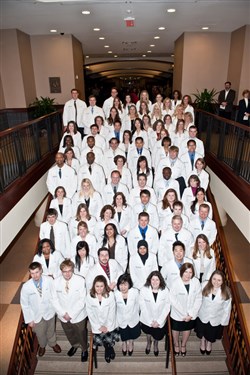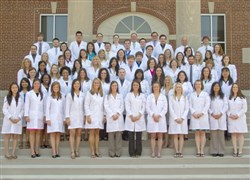VOL. 36 | NO. 18 | Friday, May 4, 2012
More new pharmacists than the market ordered
By Linda Bryant
The stereotypical image of the local pharmacist counting out pills and dispensing prescriptions from behind the drugstore counter is increasingly irrelevant.
Case in point: Belmont and Lipscomb universities are poised to release 149 new pharmacists into the workforce this month, the first graduating classes of their new pharmacy schools.
Many of these newly graduated pharmacists won’t be pursing the traditional community pharmacy career route. The Great Recession and health care reform have impacted the industry, shifting jobs away from retail settings into managed-care organizations or clinical settings such as hospitals and clinics.
And, according to some national experts, it may get harder to find a job as a pharmacist.
Some say there have been too many new pharmacy schools built nationwide. The supply of pharmacists could soon exceed the demand, it’s feared, leaving a significant amount of graduates with disappointing job prospects and a heavy student loan debt.
“It’s true that there’s been a tremendous growth rate over past two decades,” says Roger L. Davis, dean of the College of Pharmacy and Health Sciences at Lipscomb University. “There’s been concern about having too many schools in a tight geographical area.”
Indeed, pharmacy schools have burgeoned in Tennessee.
In 2006, there was one pharmacy school in the state, located at the University of Tennessee at Memphis. Now there are six, including the new schools at Lipscomb, Belmont and Union University in Jackson, all graduating their first classes this spring. Lipscomb is graduating 71 pharmacists, while Belmont has 68 graduates and Union 41.
East Tennessee State University in Johnson City and South College in Knoxville also have opened pharmacy schools since 2006.
Philip E. Johnston, professor and dean of the Belmont University College of Pharmacy, insists there’s room enough in Middle Tennessee for both Belmont and Lipscomb programs.
“We benefit from each other’s presence,” he says. “We are friends. We have a collaborative relationship. We do sometimes compete for students and faculty, but it’s at a healthy level.”

White Coat Ceremony for the Belmont University College of Pharmacy class of 2012, its first.
-- Photo Cortesy Of Belmont UniversityJohnston also says the health care landscape in Middle Tennessee, with its 15-plus hospitals and more than 250 healthcare-related companies, is an advantage for both schools.
Nashville’s location, he adds, allows the schools to forge the collaborative relationships needed to provide students with learning opportunities such as internships, residencies and individual mentorships with working pharmacists.
It’s unclear, however, how the changing face of the pharmacy profession will impact local pharmacy graduates, but Davis says students in Nashville have had an easier time adjusting to shifting sands of the market because Middle Tennessee is so rich in health care resources – hospitals, managed care companies and other healthcare-related industries.
Another factor: Tennessee is one of the neediest states when it comes to pharmacists.
The Pharmacy Manpower Project’s Aggregate Demand Index shows Tennessee ranked No.2 in demand nationwide, tied with California. Texas has the highest demand.
“Nashville is a strong base to begin from,” Davis says. “Yes, the industry is changing and there’s a tightening of the market in terms of some jobs, but the market it still strong.
“There are new opportunities for true entrepreneurships at the primary care level,” Davis adds. “There are things on the horizon such as the graying of America and the discovery of new drugs that will continue to impact the market.”
The biggest uncertainty for this year’s graduating pharmacists is exactly where they’ll be working.
”You can’t always pick which corner you want to practice on anymore,” Davis says.
Belmont’s Johnston agrees.
“There’s a shift occurring, and some people are concerned we’ll have too many (pharmacists),” he says. “I think it’s about right.”
Johnston says some employers are awaiting the outcome of health care reform. He sees new jobs forming in managed care and information technology settings.

The College of Pharmacy at Lipscomb University has 71 graduates in its first class, three more than Belmont’s 68. Union, also in its first year, has 41.
-- Photo Courtesy Of Lipscomb University; Kristi Jones, PhotographerWilliam Walker is just the kind of graduate to which Johnston is referring. Walker, 24, will head to Chattanooga after his May 5 graduation from Lipscomb to enter a one-year residency in managed care at Blue Cross Blue Shield of Tennessee.
Walker, who transferred to the Lipscomb program after two years of community college, says he always wanted to be a pharmacist, but never conceived of working a non-traditional job in pharmacy.
“I never thought I’d have a residency in managed care,” Walker says. “I thought I’d be going back home (to East Tennessee) to work in a community setting.”
Brittany Latimer, 25, is another new Lipscomb graduate headed to a managed care residency at Express Scripts in New Jersey. Latimer, who is from Charlotte, N.C., agrees that new pharmacists often have to change their ideas about working close to home.
“There are a lot of opportunities, but people need to be more open to moving,” Latimer. “I feel really lucky to have landed a residency in managed care. I’m very excited.”
Managed care pharmacy residents often deliver pharmaceutical care and expertise to the health care providers who work directly with patients.
Shanna Harris, a former high school teacher who returned to school to complete her pharmacy doctorate at Belmont, is on her way to Florida to to begin a residency at an ambulatory care center.
“It has gotten a lot tougher to find residencies, but at the same time there are all kinds of new jobs opening up,” Harris says. “Now there are clinical jobs, not just community care jobs. You probably have to be willing to relocate for your residency or job, but I’m happy to do it.”
Meanwhile, The American Pharmacists Association and the American Society of Health-System Pharmacists have both issued warnings about the rapid growth of new schools. One of their primary concerns is that the influx of new students is creating a serious shortage of qualified faculty and a heavy student debt load.
According student responses at the Student Doctor Network, a national healthcare education network, the school loan debt ranges from about $80,000 for a four-year public university program to $150,000 or more at private schools.
Davis and Johnston say Lipscomb and Belmont have enough faculty placements and a low student-to-teacher ratio.
A government-sponsored report, The Adequacy of Pharmacist Supply: 2004 to 2030, reports a projected growth of 79,000 new pharmacists from 2004 to 2020 – from 226,000 to 305,000. In 2012, there are about 219,000 pharmacists in the United States.
Belmont’s Johnston believes pharmacists will adapt well to the changing demands of the profession.
“Pharmacy attracts people who want to serve,” Johnston says. “They understand that service is more important than self.”